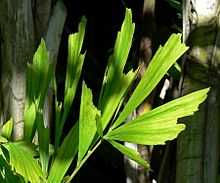Caryota
From Wikipedia, the free encyclopedia
| Caryota | |
|---|---|
 | |
| Caryota mitis leaves | |
| Scientific classification | |
| Kingdom: | Plantae |
| (unranked): | Angiosperms |
| (unranked): | Monocots |
| (unranked): | Commelinids |
| Order: | Arecales |
| Family: | Arecaceae |
| Subfamily: | Coryphoideae |
| Tribe: | Caryoteae |
| Genus: | Caryota L. |
| Species | |
|
13; See text | |
Caryota is a genus of palm trees. They are often known as fishtail palms because of the shape of their leaves. There are about 13 species native to Asia and the South Pacific. One of the more widely known species is Caryota urens, the flowers of which are used to make one type of jaggery (an unrefined sugar), and also to make palm wine. Caryota mitis is an invasive introduced species in the US state of Florida. They are also one of the few Arecaceae with bipinnate foliage. Many grow in mountainous areas and are adapted to warm mediterranean climates as well as subtropical and tropical climates.
Selected species:
- Caryota cumingii - Philippines fishtail palm
- Caryota gigas - Giant fishtail palm
- Caryota mitis - Burmese fishtail palm
- Caryota obtusa - Thailand mountain palm
- Caryota ochlandra
- Caryota rumphiana - Albert palm
- Caryota urens - jaggery palm, solitary fishtail palm, wine palm, toddy palm
- Caryota zebrina
External links
| Wikimedia Commons has media related to Caryota. |
Gallery of Images
This article is issued from Wikipedia. The text is available under the Creative Commons Attribution/Share Alike; additional terms may apply for the media files.


